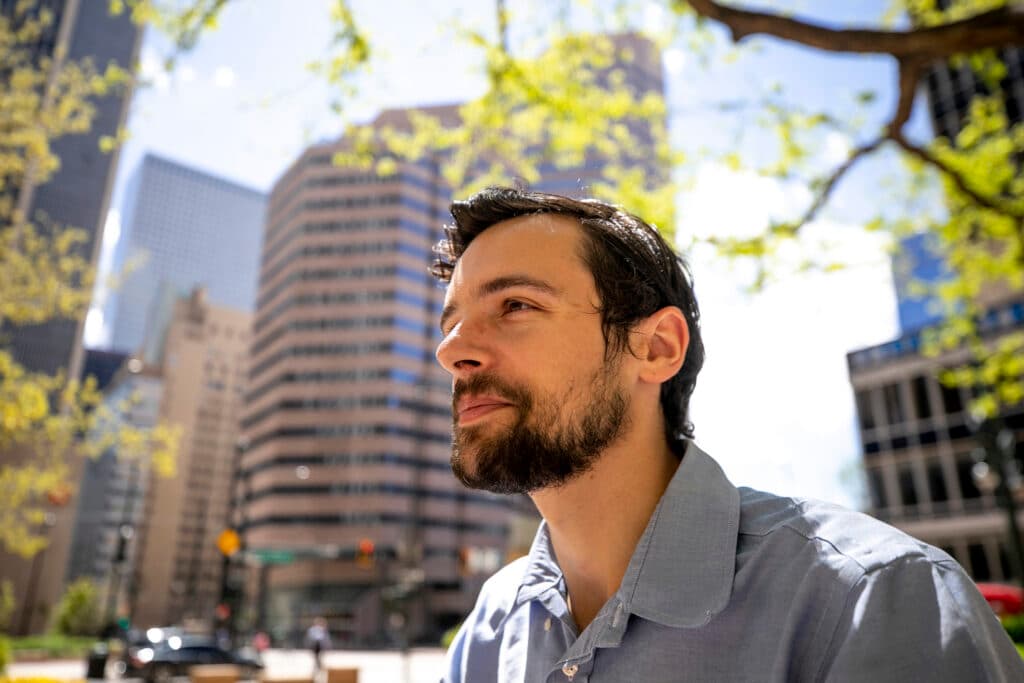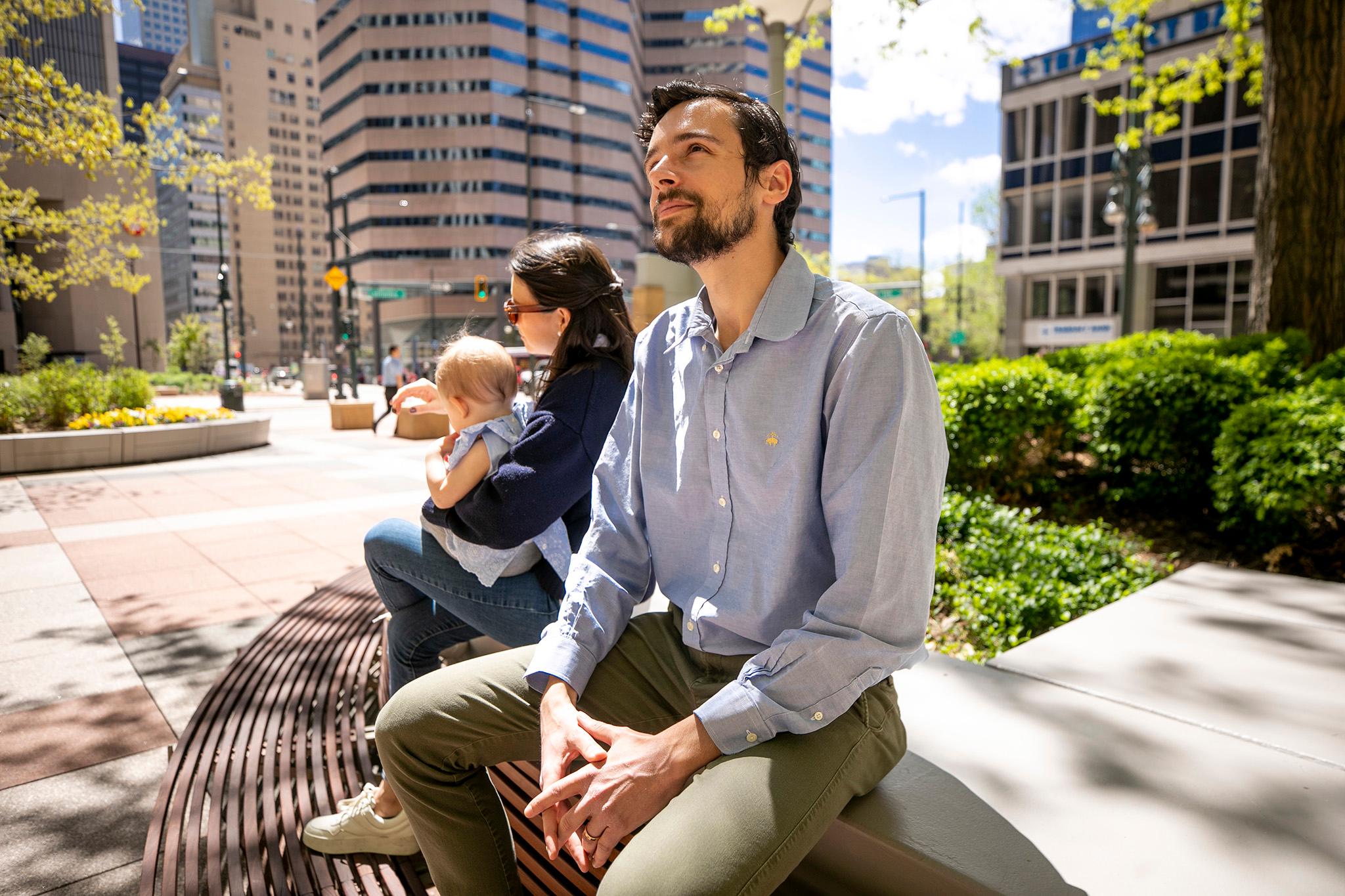When Anthony and Natalie Gemma decided to move from rural New Hampshire to Denver for his job with a landscaping firm, they watched online videos boosting different neighborhoods.
They considered RiNo, but it was too isolated and they quickly crossed it off their list. They looked at other parts of Five Points and Capitol Hill, but weren’t sold. LoDo appealed to them, but it was too expensive.
They narrowed their options down to the rising Cherry Creek or downtown’s Central Business District.
Finally, in February 2022, they landed on downtown — at a time when many had lost confidence in the city center.
Sure, downtown was still in a slump from the pandemic — a slump it’s still trying to rise from. Streets were often empty. Businesses were boarded up. Tents lined some sidewalks.
Union Station had recently been blasted as a “lawless hellhole” by the head of the transit union, garnering downtown a glut of panic-inducing headlines.
Neighbors complained of high crime and public drug use. The mayor was promising more policing, and police were arresting hundreds of people.
But crime and despair aren’t what the Gemmas saw.
Denver actually looked pretty great to them.
So they bet on the big-city promise of downtown Denver, especially what it would be if the economy would only recover.
The Gemmas bought a two-bedroom condo in Upper Downtown, a short walk from Anthony’s office.
Their home was something they could only afford if they paid over the recommended 30% of their annual income on their mortgage. But they’re budget-conscious people. They’re not worried about paying more than advised.
When they arrived, they found endless places to shop, museums to explore, parks to relax in and so many other things to do — an urban life to enjoy that they’d never really had in small-town New Hampshire.
Not long after they moved here, they tied the knot and briefly they enjoyed Denver as a couple without kids.
Months later, they were shopping at H&M on the 16th Street Mall. Natalie pointed to the to the kids' section and said they should buy something from there. Anthony wondered why. For their soon-to-be child, Natalie explained.
She was pregnant — in downtown Denver.
When friends found out about the coming kid, they started asking: When are you moving to the suburbs?
The answer, to the Gemmas, was obvious: They weren’t.
“Our apartment is perfectly comfortable,” Natalie said. “We have great neighbors.”
Anthony works a short walk away from the apartment, and she works for an out-of-state urban design company. They meet for lunch in a downtown restaurant, at Union Station or at a park. They have several grocery stores nearby and even a Target.
Sure, they might not have a yard. But who needs a yard when you can walk to Commons Park, Civic Center Park or the Denver Art Museum?
Now that their daughter is more than a year old, they still love the neighborhood — even if they’d change some things if they could.
The city is already working on addressing the big, often talked-about issues.
There are fewer encampments downtown than there were when the Gemmas moved here. Crime, too, is down in the city center. They’re eager for the 16th Street Mall to reopen, and they’re sad for how its closure has led businesses they once frequented to shut down.
Sure, they’d like to see more police on foot patrol — especially for tourists who might wonder if the presence of so many homeless people suggests a safety threat (and as they see it, it generally doesn’t). The city has been working on hiring them.

The couple subscribes to the Downtown Denver Partnership’s Safe and Clean app. It allows neighbors to report quality-of-life issues and problems that don’t require a 911 call.
“I'd say 90% of the time, if, you know, there's a broken glass bottle on the sidewalk and I flag it, it's gone two hours later,” Anthony said. “The city's definitely making an effort.”
While they view the headlines about downtown crime and safety to be overblown and panic-inducing, they do have one big safety concern they wish more people would talk about: Traffic safety.
There are too many speeding cars, as they see it, and not enough people getting tickets.
“We're on the streets every single day,” Anthony explained. “I walk from one end of the downtown to the other twice a day for work. I've never seen a traffic stop downtown. And I can't tell you how many times I mean — if you walk from Wynkoop to Glenarm, where we live — there will be three crosswalks where some car blows through it.”
“That’s not to say that we can’t walk,” Natalie added. “Obviously we do it every day. But we need to do it knowing that when we get the green light to walk, we have to wait three to five seconds.”
If they don’t, they could be hit by an SUV.
The couple wishes they had a higher-quality nearby public park they felt comfortable using.
Their nearest park is Skyline Park, a place where people have long gathered to use drugs and that, otherwise, has rarely taken off as a community hub. There aren’t many trees there, there aren’t cool spots for the family to enjoy a picnic, and there isn’t a playground.
They wish there was a little grass, where they could sit down and have a picnic.
Natalie wishes Skyline was like their “little Central Park," but for now, it isn't. She plans to share her input on its future as the city figures out what to do next with it.
Meanwhile, the family doesn’t feel particularly comfortable going there, so they walk farther, to nearby parks or even the Children’s Museum.
As they look around downtown, they see possibility for future parks, eying the parking lots and former buildings where parks could be built.
“There’s these missing teeth in the fabric of the city that if they were really smart about it, maybe they’d look at how we can get a few more parks,” Anthony said.
But maybe creating new parks isn’t necessary. Instead, the city could make what’s already there more accessible for families.
“I don’t think you even need to add a few more parks,” added Natalie. Skyline Park should be enough. “It’s three blocks, so it’s not a small park… We have the bones here. It’s just using those bones in the right way.”

She would also like to see trees lining downtown streets. The family’s building has struggled through a long, costly process to get permission to add new trees in front of their building. They’d like to see associated costs cut and the process sped up.
Union Station, as they see it, did it right, planting trees in front of the building, and they wish that strategy rippled through downtown.
“We’re people that walk all the time," Natalie said. "Having that shade makes the biggest difference in the world. It’s unbelievable. And the value that it adds to your mental health to, see greenery and feel that coolness — that’s the other thing for me.”
So are they glad they landed downtown or do they regret not moving to Cherry Creek?
Anthony says Cherry Creek is still nice, but it feels too flashy, new and generic.
They go to Cherry Creek for shopping and the art market, with some frustration that the neighborhood is hard to get to from downtown. And while they like what Cherry Creek has to offer, they could find what it has to offer in any big city.
“If you value local character, the regional character, you don’t find that in Cherry Creek,” Anthony said.
As a mom, who only works 15 hours a week and spends most of her time with her child, Natalie believes she'd get bored in Cherry Creek. There’s just not enough to do. Downtown, on the other hand, has endless possibilities.
“After living here for two years, I wouldn’t change to go to Cherry Creek for anything in the world,” she said.










